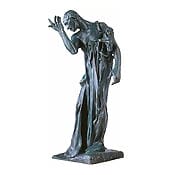The replica impresses with its quality and excellent craftsmanship. The green and black polymer ars mundi museum replica, hand-cast, contrasts effectively with the gilded horns.
Original: Heraklion Archaeological Museum, Crete. New Palace, Knossos. Late Minoan, 16th century BC. Height including base: 56.5 cm.
Base dimensions: 12 x 11 x 12 cm (W/H/D). Weight: 11 kg.
Contact Seller966XXXXX
Buy Artwork
€ 990,00
Cretan art is also called Minoan art after the legendary King Minos. Cretan-Minoan art refers to the art of Crete from approximately 2900–1600 BC (Minoan art), and Mycenaean art of Crete and the Greek mainland from approximately 1600–1100 BC, although on Crete it only dates back to 1200 BC. In the shaft tombs of Mycenae, which flourished in the 14th and 13th centuries BC, the German archaeologist Heinrich Schliemann discovered significant evidence of this culture. One surviving example is the Lion Gate from the 13th century BC. Ceramic works of art have best survived the turmoil of the millennia: magnificently decorated vases. Famous is the Snake Goddess (c. 1500 BC), a faience statuette recovered from the rubble of the palace sanctuary at Knossos. Bronze vessels of the period were mostly used in the home. Daggers, swords, and armor were also made of bronze. The jewelry of Cretan-Mycenaean women was made of gold, rock crystal, lapis lazuli, ivory, faience, and glass.
classicism
casting technology
plastic
Replica
animals
- Gold
- Green
- Black
- (Office) Desk
- Side and lowboards, consoles, fireplace mantel
- shelf
- Indoor
- Solo Placement
- Eclecticism
- Elegant
- Exotic
- folklore
- Pompous / Gloss & Glamour







